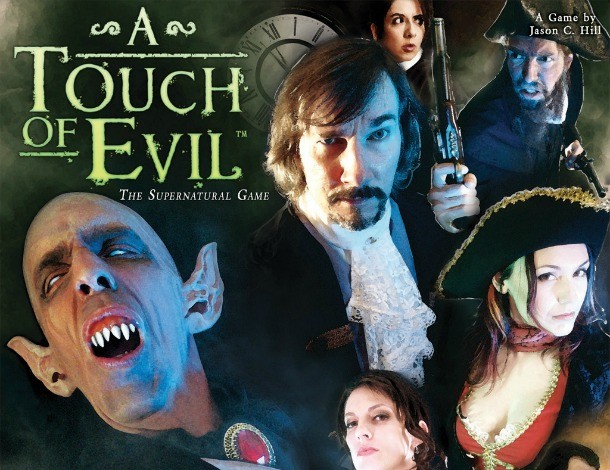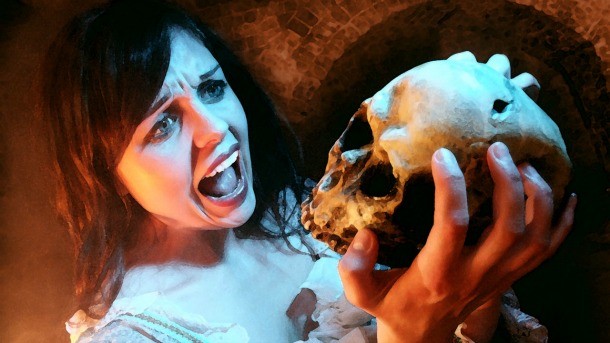Subscribe today to receive the next issue of Game Informer, featuring the Most Anticipated Games of 2026!
Top Of The Table – A Touch Of Evil

Video gamers often bemoan familiar settings and situations in the titles we play. It’s easy to get fed up with World War II shooters, swords and sorcery, or modern-day action games. Thankfully, plenty of developers are consciously moving their work into more original territory. If you don’t mind jumping ship to the tabletop scene, you’ll find a wealth of interesting settings being explored. One of my favorites is Flying Frog Productions’ A Touch of Evil, this month’s Top of the Table pick. Read on to decide if this 19th century horror game is right for you and your group.
Getting Started
A Touch of Evil is a highly flexible game, allowing two to eight players to engage in a fast-moving investigation and confrontation against a supernatural threat facing the unfortunate 19th century town of Shadowbrook. Players choose which rules to play with, keeping things simple or making them more complex as desired. The basic version of the game has players each working independently and competing to bring down the big baddie, but equally fun is the included cooperative play option that lets everyone work together against an even more powerful version of the foe. Advanced rules allow more experienced groups to add new layers, like the possibility of players becoming werewolves themselves, competitive team options, and more complex interactions with the villain’s minions.
Setup is straightforward thanks to an included picture in the instructions that shows you where everything goes (see below). The game has plenty of components, so it’s a good idea to keep some small bowls or cups on the table to hold everything rather than scatter everything out in a mess.
As you lay those components out for the first time, you’ll be struck by the incredible production quality on display in everything from the card stock to the game figure pieces, which all have gorgeous but unpainted sculpts. The board looks like an old parchment map showing the town and its surrounding points of interest. Characters in highly stylized costumes are depicted by a gorgeous but unusual amalgam of photography and art overlay, with a result that recalls early- to mid-20th century horror filmmaking. Monsters are half scary/half campy, reminiscent of the vampire from 1922’s Nosferatu and Boris Karloff’s monster from The Bride of Frankenstein. The exaggerated, anachronistic art style may take a bit to get used to; for my part, I loved the callback to the cinematic roots of horror.
Turns move quickly, especially in comparison with many other storytelling adventure games. This keeps all the players engaged in the action, especially during the cooperative scenarios in which everyone plots together to succeed. However, game length is highly variable based on number of players. My early games with smaller groups took a couple of hours and sped up as we learned the games. If planning to play with a larger group, my experience suggests you budget at least two to three hours.

Theme and Story
A Touch of Evil basks in its rich, cinematic heritage, and unfolds the 19th century horror theme in all sorts of cool ways. Each player takes on an iconic character role, like the big-city Inspector Cooke, Katarina the sexy outlaw, or buttoned-up school teacher Anne Marie. Each character has his or her own strengths and weaknesses and a special ability that speaks to their unique talents.
While the town of Shadowbrook remains the same, each game brings a different villain into play – the four included in the base game are the vampire, werewolf, spectral horseman, and scarecrow. My personal favorite is undoubtedly the homage to The Legend of Sleepy Hollow; the spectral horseman appears during his scenario from time to time, taking swipes at characters as he gallops past.
The horror theme pervades the story-based events and locations you visit, which call to mind familiar horror clichés like a secret passages in the old manor and horrible beasts hidden in the dark of the abandoned windmill.
Some of the biggest thematic game elements, secrecy and betrayal, are communicated through the inclusion of six town elders who each harbor some mysterious secret. Over the course of the game, players uncover these secrets – which might be the innocuous discovery that one of them is a drunk, or could reveal that they are in fact working for the villain. Their cards flip, and they take on sinister (often amusing) alter-ego personas.
The cinematic arc at the core of the gameplay reaches a climax as the hero (or heroes if playing cooperatively) hunt down the villain’s lair and engage in a final showdown. The mechanic makes for a great endgame, rather than allowing the game to simply run out of steam in the final turns.
Taken together, each playthrough ends up feeling like it has its own story arc. In my experience, most players began to craft their own stories about the good and bad fortunes of their characters, and who got along with whom. I also love the randomized idiosyncrasies of the town elders and the way each villain adds its own special tone.

[Next up: How is the game played?]

Gameplay
Flying Frog’s supernatural board game is played in a fast-paced flow of turns around the table. Unlike many hobby board games, an individual turn for a player comes and goes quickly; players move, fight enemies on their space, and take one of a handful of actions on their new space, like healing, investigating a town elder’s secrets, or drawing an event that occurs out on the road.
Individual players quickly discover that the game has an easily understandable flow. You’ll set out from the town well-equipped, and head to one of the corner locations of the board in search of clues, allies, and items that might aid you in the inevitable showdown. Commonly, these short adventures take two or three turns, after which you may very well need to return to town to heal up, buy new items, or improve your skills for more adventures.
Combat with monsters and other encounters usually involves a simple dice-based test of one of your character’s skills. This luck-based component can be steered to victory by smart use of items and other abilities, but any way you cut it, it does lend a high element of chance into the equation of how the story unfolds.

After each player takes a turn, a mystery phase moves the villain closer to victory. The town falls deeper into darkness (as presented on a simple shadow tracking chart that lays out on the table), and new minions of the bad guy show up; these lesser enemies are different for each major villain, further expanding the replay potential. I also love how even in the competitive mode, the shadow tracker allows the possibility for the villain to win instead of a player.
Most of the time, that natural flow of moving out into the wilderness and returning to town makes for a fun loop, but I did find the chance-based encounters out in the wilds often devastating to a character’s health, leaving players with the unfortunate decision of having to run back to town for healing or risking a knockout, which can take a heavy toll on your collection of items and other acquisitions.
The final showdown mentioned above was fun for the whole group in every game I played, during which players throw down against the chief villain and try to end the threat to Shadowbrook once and for all. This longer encounter brings allies and town elders into the mix, and in a competitive game, there are even ways to impede other players so they don’t win the game before you have a chance to complete your own showdown. When cooperating, the final villain is freakishly powerful, and I loved the way my fellow players cheered each other on as we chipped away at the monster’s health.

[Next up: How complicated is A Touch of Evil? Plus, details on the expansions]

Complexity
The game includes lots of pieces and cards, but clear labeling and color usage makes it easy to figure out where everything lays out on the table. A clearly written instruction manual details all the game rules in an easily understandable format, and it was rare in my early games that I ran into a situation that wasn’t clearly addressed in the book – but it has no index or contents, so I occasionally found myself digging for the right section.
Many hobby games demand that every player have a clear and comprehensive understanding of the rules in order to succeed, but A Touch of Evil is more welcoming to new players. As long as someone at the table has a clear sense of turn order and the notation used in the simple skill tests mechanic, it’s easy for a large group of players to pick things up quickly.
While I love the endgame showdowns, I found that the included option of wound tokens to mark enemy health to be a little cumbersome; my solution was to just keep a scrap of paper handy for that multiple-round fight, which made things easier, especially during the lengthy cooperative showdowns.

What Else Do I Need To Know?
A Touch of Evil includes a number of expansions that add more to the game, though I can’t speak to their quality having not yet had the chance to check them out. If the opportunity arises in the future to give them a try, I’ll update with my thoughts here. With that said, two larger expansions (Something Wicked and The Coast) each add a new board, new villains, and new heroes to play, allowing players to open up Shadowbrook into an expanded map on both sides. Two other smaller hero pack expansions each add yet more heroes and villains. In short, players who enjoy A Touch of Evil have a lot of choices for how to grow the game.
A Touch of Evil is very affordable as high-end board games go, especially ones that have similarly high production values. Most online retailers list the game for between $35 and $60. You can purchase from Flying Frog directly, and we also recommend CoolStuffInc, Thought Hammer, or Amazon.
A Touch of Evil is squarely targeted to gaming groups who enjoy fast turns and highly thematic horror storytelling. The cinematic art style helps the game stand out; some players will love the call back to period costumes and pulpy picture style, while others might find it all too cheesy. If you’re open to the vibe Flying Frog is shooting for, you’ll love it. Some gamers may be familiar with the popular Arkham Horror board game from Fantasy Flight, which shares similar traits of horror and cooperative play opportunities. A Touch of Evil is an easy recommendation if you already like Arkham Horror, but there are some important distinctions between the two games. A Touch of Evil is simpler and more streamlined in turn structure, and games are usually shorter, but Arkham Horror also presents more variety in locations and potential events and items. They’re both excellent games, and for some, a choice of which to play on a given night might be the group’s leaning towards 19th century horror over Lovecraftian lore.
For more about A Touch of Evil, you may wish to check out the official Flying Frog wiki. For other tabletop games we recommend to pull you away from your video game screens, you may enjoy our write-ups on games like Ascension, Tannhauser, Castle Ravenloft, Yomi, Star Trek: Fleet Captains, or Agents of SMERSH.








